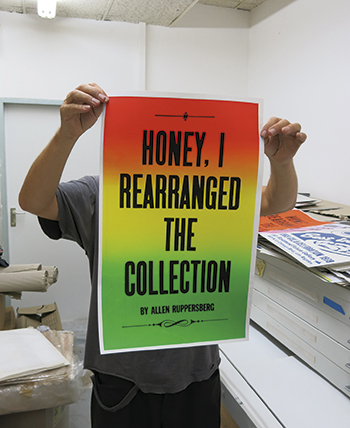Arquivo
2014
Cartazes da Coleção Lempert (capítulo 1 / 1.ª parte)
A 15 DE MARÇO DE 2015
2€ · Entrada gratuita aos domingos
e no dia 1 de janeiro de 2015.
Visita guiada
por Frederico Duarte
Sábado, 8 de novembro, 17h
Visita guiada
por Sofia Gonçalves
Sábado, 22 de novembro, 17h

Desvendamos aqui e agora parte de uma extraordinária coleção de cartazes de artista e de exposição, iniciada na década de 1960 e composta atualmente por cerca de 15 mil espécimes. A coleção será mostrada numa série de cinco exposições que irão pontuar o programa da Culturgest até ao final de 2018. O projeto desdobra-se em três capítulos; e como o título sugere (um título pedido de empréstimo a um conjunto de obras do artista Allen Ruppersberg), esses objetos são selecionados e organizados segundo diferentes perspetivas. No primeiro capítulo, a ser completado com uma segunda exposição imediatamente a seguir a esta, são destacados os cartazes de vários artistas que a esse meio dedicaram especial atenção. No segundo, igualmente desdobrado por duas exposições consecutivas, os cartazes serão selecionados e organizados por tópico. Finalmente, os cartazes escolhidos serão alinhados por ordem cronológica.
Por que razão tantos artistas, sobretudo a partir da década de 1960, produziram tantos cartazes, na sua maioria para anunciar as suas próprias exposições, não deixando esse meio de comunicação por mãos alheias (de designers, galerias, instituições)? Por que razão tantos artistas continuaram a produzir cartazes na época da comunicação eletrónica, em que o cartaz foi destronado e tornado obsoleto por meios mais rápidos, mais eficazes e mais económicos de divulgação das exposições?
Estes artistas põem em jogo nos seus cartazes as preocupações, as ideias e as linguagens que caracterizam o seu trabalho num dado momento. Mas não se trata de um simples jogo de reflexos; para muitos deles, os cartazes não estão apenas sob a jurisdição da sua prática artística, mas são parte integrante do seu trabalho, são objetos que valem em si mesmos e por si mesmos, para além (muitas vezes aquém) da sua função de divulgação, frequentemente à revelia de critérios de eficácia comunicacional. Nessa medida, quando vistos no seu conjunto, os cartazes proporcionam uma viagem tão surpreendente quanto fascinante pela obra (e pela carreira) destes artistas. À medida que vamos percorrendo a exposição, somos conduzidos numa viagem igualmente apaixonante pelos meandros da história da arte nos últimos cinquenta anos.
Unveiled here is part of an extraordinary collection of artist's and exhibition posters begun in the 1960s and now comprising roughly 15,000 items. The collection will be displayed in a series of five exhibitions interspersed in the course of the Culturgest programme until late 2018. The project is divided into three chapters, and, as the title suggests (a title borrowed from a group of works by the artist Allen Ruppersberg), these objects are selected and arranged according to different perspectives. In the first chapter, which will be completed with a second exhibition held immediately after this one, various artists who have devoted special attention to this medium are highlighted. In the second, which will also be divided into two consecutive exhibitions, the posters are selected and arranged by topics. In the last one, the selected posters will be displayed in chronological order.
Why did so many artists – especially from the 1960s onwards – produce so many posters, mainly to advertise their own exhibitions, while refusing to let this means of communication fall into the hands of others (designers, galleries, institutions)? Why have so many artists continued to produce posters in the age of electronic communication, when the poster has been superseded and rendered obsolete by media that offer a faster, cheaper and more effective way of promoting exhibitions?
In their posters, these artists bring to the fore the concerns, ideas and languages that characterise their work at a given moment. Yet it is not a simple game of reflections. For many of them, posters are not solely governed by their artistic practice; instead they form an integral part of their oeuvre, they are valued in themselves and for themselves, besides (and frequently in detriment to) their promotional function, and often in defiance of the criteria of communicational effectiveness. Accordingly, when seen as a whole, the posters offer us a surprising and fascinating voyage through the work (and career) of these artists. As we make our way through the exhibition, we are taken on an equally adventurous journey through the history of art in the last fifty years.
